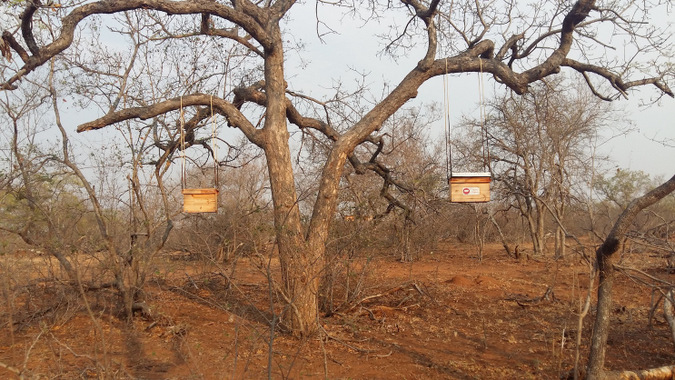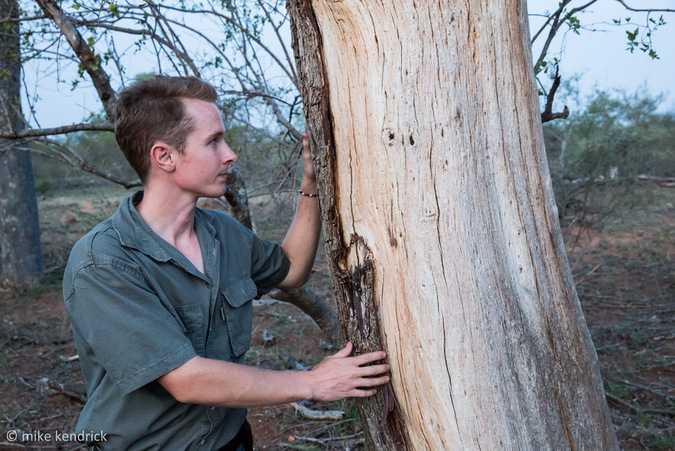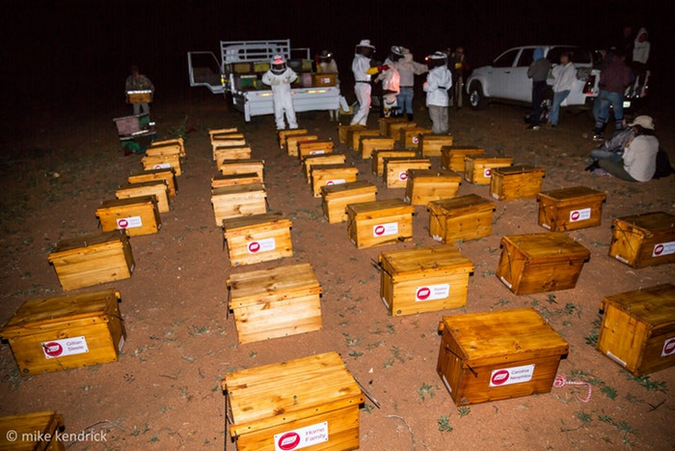
A study has found that hanging beehives containing African honeybees from the branches of marula trees protects these trees against elephant impact because the elephants avoid those trees. Only 2% of trees with beehives incurred elephant impact, compared to 54% of trees in the research block that had no deterrents.
“This innovative study demonstrates that there are peaceful means with which we can foster the important ecological linkages between elephants, trees and bees. The bees not only protect the large trees from severe impact but as pollinators they also ensure valuable seed banks for the surrounding landscapes,” said Elephants Alive’s Director and Principle Researcher Dr Michelle Henley. “Elephants are important seed disperses to marula trees, so protecting selected iconic tree specimens while leaving others, as this study clearly illustrates, will ensure harmonious coexistence amongst three vital ecosystem components.”
The research was conducted by South African based Elephants Alive and the University of the Witwatersrand, Johannesburg, in partnership with the Elephants and Bees Project of Save the Elephants in Kenya.

Conservation managers in fenced-off protected areas are concerned about the impact that expanding African elephant numbers have on the survival rate of large tree species, necessitating the need for mitigation methods. One such mitigation method, wire-netting, has proven to be successful at increasing trees’ survival rates by preventing elephants from ring-barking these trees. However, wire-netted trees are still vulnerable to other types of elephant impact, such as breaking off branches and uprooting the tree. This requires researchers to investigate new methods which may be effective at completely deterring elephants from particular large trees.
Building off Save the Elephants’ research on using African honeybees to mitigate elephant impact on crop fields, the study showed that hanging a combination of both active and dummy (inactive) beehives from the branches of marula trees creates a formidable mitigation method for protecting this keystone species from elephant impact.

The investigation, led by Elephants Alive researcher Robin Cook, who is studying for his Master of Science degree at the University of the Witwatersrand (Centre for African Ecology), monitored elephant impact on 150 marula trees in a 30 hectare (75 acre) experimental plot in Jejane Private Nature Reserve, which is part of a larger association of reserves sharing unfenced borders with Kruger National Park. The 150 marula trees were subdivided into 50 beehive trees, 50 wire-netted trees, and 50 control (no treatment) trees. For this study, 50 active beehives were brought into Jejane and hung overnight in their 50 respective trees.
Elephant impact on the 150 trees was monitored between December 2015 and September 2016, with the researchers focusing on various elephant impact-types such as bark-stripping, primary and secondary branch breakage, main stem snapping, and uprooting. Dung transects were also carried out in the experimental plot and a neighbouring control plot in an attempt to gain an understanding of the spatial effect that the beehives had on elephant movements.

The study took place during a severe drought in South Africa and so a feeding regime was pioneered to supplement the honeybees with pollen, nectar, as well as sugar water inside the experimental plot. This feeding regime, along with maintenance costs, led the researchers to further compare the feasibility of the beehive method by focusing on the costs and benefits of the beehive versus wire-netting mitigation-methods.
“Whilst initial installation costs of the beehive method may be relatively high in comparison to wire-netting, there is a possibility of honey production and an additional financial revenue for protected areas which implement this method,” says Cook. “Feeding costs will also be reduced or even eliminated in areas with an abundance of water and flowers for the honeybees to sustain themselves.”
“This exciting research indicates that beehives could be a valuable ‘tool’ in the toolbox of methods for protecting large trees from elephant impact in fenced-off protected areas” said Dr Lucy King, founder of Save the Elephants’ Elephants and Bees Project, “Particularly as it is a non-lethal method for elephant management”.

Key findings from the study include:
• Only 2% of trees with beehives received elephant impact, in comparison to 28% wire-netted and 54% control trees.
• Beehives were more effective than wire-netting at protecting trees from impact.
• Beehives in trees are effective at protecting the individual tree from elephant impact but do not prevent elephants from impacting neighbouring trees.
• Beehives were more expensive than wire-netting, and require greater maintenance.
• For protected areas with logistic and financial resources, beehives can provide a valuable alternative method for protecting large trees from elephant impact.
Thanks to the generous funding of EMS Foundation, the wooden beehives in the experimental plot have been upgraded to a longer-lasting model to ensure that the research will carry on over a longer period of time, with the additional focus on honey production.
Contact Robin Cook for more information regarding this research project.
The full report: Science Direct, R.M. Cook, F. Parrini, L.E. King, E.T.F. Witkowski, M.D. Henley: “African honeybees as a mitigation method for elephant impact on trees”
To comment on this story: Login (or sign up) to our app here - it's a troll-free safe place 🙂.![]()








